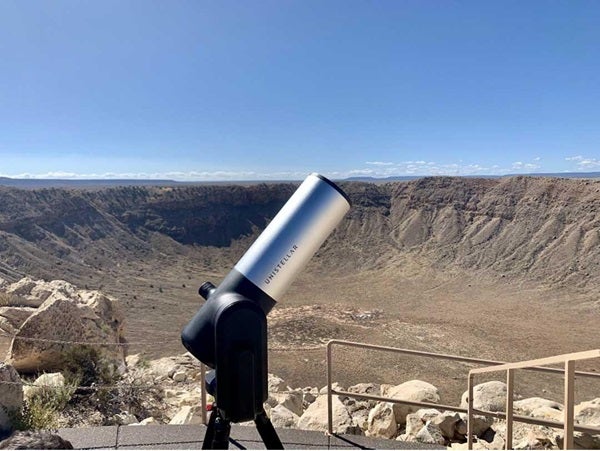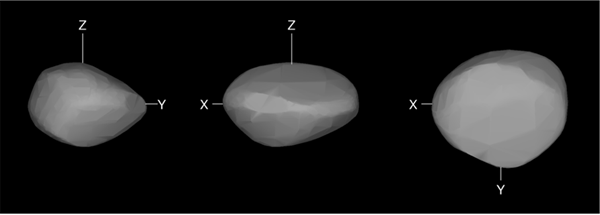In the battle to defend the planet from hazardous asteroids, amateur astronomers have taken on a new role — for the first time, helping to map a near-Earth asteroid (NEA), revealing its shape.
The effort came as a collaboration between researchers at the SETI Institute and 26 citizen observers from seven countries who observed the 1.2-mile-wide (2 kilometers) asteroid 1999 AP10. All of the observers were using an eVscope — a new “smart” telescope model produced by the startup Unistellar.
How to map a space rock
Amateur astronomers have always been on the front lines of planetary defense as discoverers of asteroids and comets. Their observations and submissions to organizations like the Minor Planet Center are invaluable in tracking objects that could one day collide with Earth.
But this is the first time that amateur observers have teamed with researchers to generate a detailed model of the shape of an asteroid. They used a technique called light curve inversion, which analyzes how an object changes brightness as it tumbles and rotates through space, reflecting sunlight differently at every angle. Using the 81 sets of observations that eVscope users collected over October and November — plus some archival data from 2009 — the researchers were able to reverse engineer the asteroid’s physical shape.
Previously, astronomers had determined the shapes of only 68 other near-Earth asteroids, mostly using powerful planetary radar facilities to do so.
The team presented their results on December 9 at the 2020 fall meeting of the American Geophysical Union, held online.
A crowdsourcing game-changer
The results are also a milestone for the eVscope, which began as a Kickstarter campaign in 2017. The initial campaign was so successful it spawned the company Unistellar, which has now shipped about 3,000 eVscopes to users.
The eVscope’s main claim to fame is that instead of an optical eyepiece, it has a built-in CMOS sensor and can stack images on the fly. Users can view the results on a paired smartphone or peer into the telescope’s electronic “eyepiece,” which projects an image from an OLED screen, similar to electronic viewfinders commonly found on mirrorless cameras.
Another key feature is that users can participate in observing campaigns developed through a partnership between Unistellar and scientists from the SETI Institute.
Franck Marchis of the SETI Institute tells Astronomy that the ability to tap into a network of thousands of identical eVscopes is a “game-changer” because results from standardized equipment can be combined more consistently. “You know that the telescopes react with the same sensitivity, the same quantum efficiency, the same profile of different colors,” he says. “That means we can clearly identify if there is an issue coming from the seeing, from the sky quality, or from the wind.”
Plus, instead of relying only on advanced amateurs who know how to calibrate their equipment and process their data, the science team can program the eVscope to do it automatically, allowing anyone to participate.
Filling Arecibo’s gap
Marchis hopes to compare their model of 1999 AP10 with forthcoming results from the Goldstone Solar System Radar, which also observed the asteroid this fall. But already the campaign has demonstrated the eVscope’s potential for including amateur astronomers in scientific research, he says.
Other researchers agree. “I think this is a great public engagement project that can provide useful and helpful data for asteroid research, including planetary defense,” says Anne Virkki, who heads the planetary radar team at Arecibo Observatory.
Arecibo’s 1,000-foot-wide (305 meters) radio telescope was the world’s most powerful planetary radar before it collapsed following a series of cable failures this fall. Its loss was a big blow to planetary defense efforts — NASA funded the observatory to observe near-Earth objects, mapping their shapes and surfaces.
Although comparing the eVscope to a planetary radar like Arecibo is “a bit of an apples-and oranges comparison,” says Virkki, “more data is always a plus, and having the public engaged in participating and helping is even a bigger plus.”
The crowdsourced light curve approach does have limitations. Unlike planetary radars such as Arecibo, the eVscope network struggles to detect depressions on an asteroid’s surface (e.g., impact craters). That’s because the math behind the light curve inversion approach assumes the object is entirely convex, with no low-lying regions.
Arecibo could also observe more objects, obtaining high-resolution images of 20 to 30 NEAs per year, according to Virkki. Marchis hopes that the eVscope network will map one or two NEAs annually. But still, he says, the eVscope network represents an alternative approach that can help “fill up the gap left by Arecibo.”
“Arecibo was a great telescope, but still a telescope that was built in the 1960s, when we were building these gigantic facilities to learn about the cosmos used by a few people,” Marchis says. “We are reaching a moment where we can democratize astronomy and make it accessible to a lot of people.”











